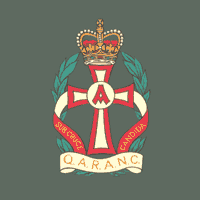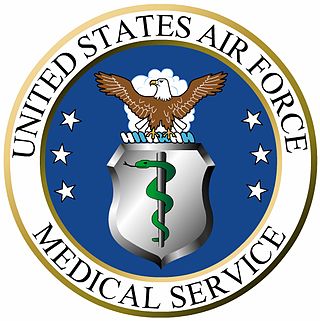
Uniformed Services University of the Health Sciences (USU) is a health science university of the U.S. federal government. The primary mission of the school is to prepare graduates for service to the U.S. at home and abroad as uniformed health professionals, scientists and leaders; by conducting cutting-edge, military-relevant research; by leading the Military Health System in key functional and intellectual areas; and by providing operational support to units around the world.
Colonel commandant is a military title used in the armed forces of some English-speaking countries. The title, not a substantive military rank, could denote a senior colonel with authority over fellow colonels. Today, the holder often has an honorary role outside the executive military structure, such as advocacy for the troops.

Most professional militaries employ specialised military nurses or nursing sisters. They are often organised as a distinct nursing corps. Florence Nightingale formed the first nucleus of a recognised Nursing Service for the British Army during the Crimean War in 1854. In the same theatre of the same war, Professor Nikolai Ivanovich Pirogov and the Grand Duchess Yelena Pavlovna originated Russian traditions of recruiting and training military nurses – associated especially with besieged Sevastopol (1854–1855). Following the war Nightingale fought to institute the employment of women nurses in British military hospitals, and by 1860 she had succeeded in establishing an Army Training School for military nurses at the Royal Victoria Military Hospital in Netley, Hampshire, England.
The Indian Army, the land component of the Indian Armed Forces, follows a certain hierarchy of rank designations and insignia derived from the erstwhile British Indian Army (BIA).

Queen Alexandra's Royal Army Nursing Corps is the nursing branch of the British Army Medical Services.

The United States Air Force Medical Service (AFMS) consists of the five distinct medical corps of the Air Force and enlisted medical technicians. The AFMS was created in 1949 after the newly independent Air Force's first Surgeon General, Maj. General Malcolm C. Grow (1887–1960), convinced the United States Army and President Harry S. Truman that the Air Force needed its own medical service.

The Territorial Army (TA) is a military reserve force composed of part-time volunteers who provide support services to the Indian Army. It consists of officers, junior commissioned officers, non-commissioned officers and other personnel who hold ranks identical to those in the Indian Army, and also maintains civilian occupations. The primary role of the TA is to "relieve the regular army from static duties and assist civil administration in dealing with natural calamities and maintenance of essential services" and to "provide units for the regular army as and when required".

The Indian Medical Service (IMS) was a military medical service in British India, which also had some civilian functions. It served during the two World Wars, and remained in existence until the independence of India in 1947. Many of its officers, who were both British and Indian, served in civilian hospitals.

Combined Military Hospitals are Pakistan Armed Forces hospitals situated in various cantonments of Pakistan.
Brigadier Dame Anne Thomson, was a British military nurse, matron and nursing administrator. She was Matron-in-Chief of Queen Alexandra's Royal Army Nursing Corps (QARANC) from 1948 to 31 January 1949, and Director of Army Nursing Services from 1 February 1949 to 1952. She was succeeded by Dame Helen Gillespie.

The Army Medical Corps is a specialist corps in the Indian Army, which primarily provides medical services to all Army personnel, serving and veterans, along with their families. Along with the branches in the Indian Navy and Indian Air Force, it forms part of the Armed Forces Medical Services (AFMS). The AFMS consists of around 60,000 personnel.
Brigadier Dame Cecilie Monica Golding, was a British Army nurse and nursing administrator who rose to Colonel Commandant, Matron-in-Chief and Director of the Queen Alexandra's Royal Army Nursing Corps (QARANC).

The United States Army Nurse Corps (USANC) was formally established by the U.S. Congress in 1901. It is one of the six medical special branches of officers which – along with medical enlisted soldiers – comprise the Army Medical Department (AMEDD). The ANC is the nursing service for the U.S. Army and provides nursing staff in support of the Department of Defense medical plans. The ANC is composed entirely of Registered Nurses (RNs) but also includes Nurse Practitioners.
Dame Louisa Jane Wilkinson, was a British military nurse and nursing administrator who served as Matron-in-Chief of the Queen Alexandra's Imperial Military Nursing Service (QAIMNS) from 1944 to 1948. She founded Queen Alexandra's Royal Army Nursing Corps (QARANC), and was also president of the Royal College of Nursing.

In the Indian Armed Forces women are allowed to join in combat service support branches and in non combatant roles only and they can only become officers except the Corps of Military Police of the Indian Army where women can become sepoys too. The Indian Air Force had 13.09% (2018) and 8.50% (2014) women; the Indian Navy 6% (2018) and 3% (2014); the Indian Army 3.80% (2018) and 3% (2014). As of 2020, three officers have the rank of lieutenant-general or equivalent, all in the Medical Services. In May 2021, 83 women were inducted as sepoys for the first time in the Indian Army, in the Corps of Military Police.
Army Hospital (Research And Referral), also known as Army Hospital (R&R), AH (R&R) and RR Hospital, is the apex flagship medical care centre for the armed forces of India. Completed in the mid 1990s, the hospital, which includes a teaching hospital and nursing college, is located in Delhi Cantonment, New Delhi. It is the only Armed Forces Medical Services hospital to be commanded by a Lieutenant General rank officer and provides for 27 sub-specialties. The hospital is also meant to cater to the President of India and the chiefs of the military.

The Director General Armed Forces Medical Services (DGAFMS) is the head of the Armed Forces Medical Services of the Indian Armed Forces. A three-star rank medical flag officer, the DGAFMS is equivalent to Army Commanders and the Defence Secretary. The DGAFMS is the advisor to the Chief of Defence Staff (CDS) and the Minister of Defence on the medical requirements of the Armed Forces.

Carol Margaret Kefford is a British nurse who has served as Clinical Director and Chief Nurse for Nuffield Health and since 2017 is a Colonel Commandant of the Queen Alexandra's Royal Army Nursing Corps (QARANC). She is currently the Chief Nursing Executive for HCA Healthcare UK.
This is a timeline of women in the Indian military and Coast Guard.
The Armed Force Medical Services (AFMS) is an inter services organisation under the Ministry of Defense, covering the Indian Armed Forces. It came into existence in 1948. The Director General Armed Forces Medical Services, a three-star officer, is the head of the Armed Forces Medical Services and is responsible to the Government for the overall medical policy in so far as they relate to the Armed Forces.













